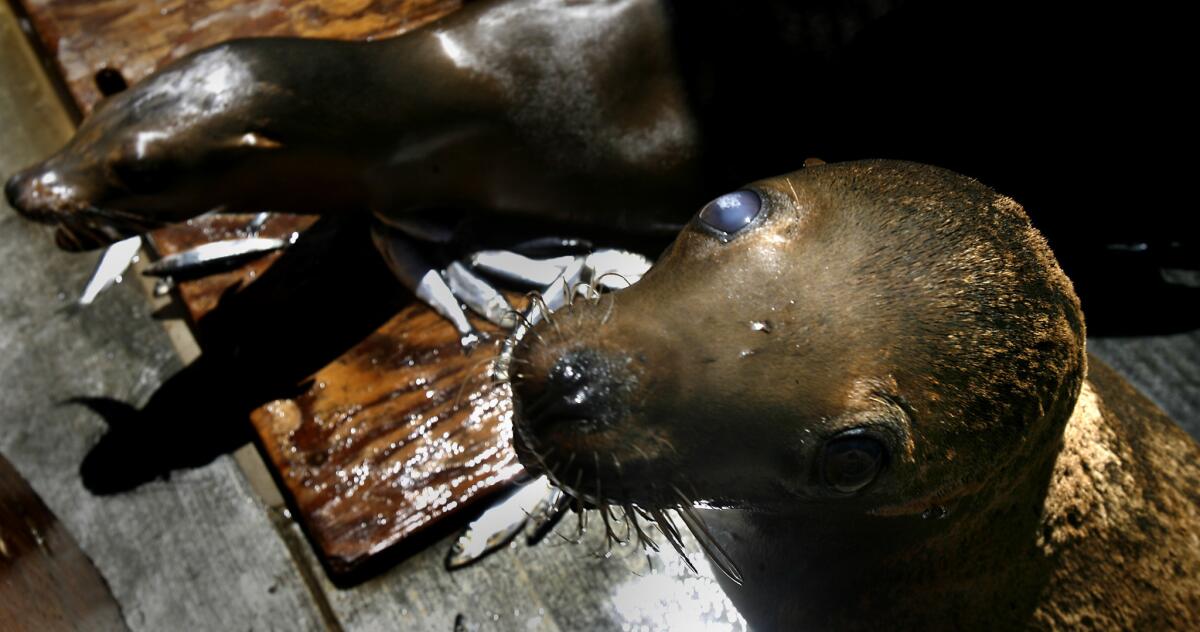Toxic algae bloom shuts down West Coast fisheries

Sea lions poisoned with domoic acid sit in recovery pens at the Marine Mammal Care Center in San Pedro in 2007. A recent, huge bloom of algae off the West Coast has killed sea birds and sickened marine mammals from Central to Northern California, experts found.
- Share via
One of the largest toxic algae blooms seen off California has shut down recreational and commercial fishing along the West Coast and could be contributing to a host of sea lion strandings in the Bay Area, scientists said this week.
The algae, pseudo-nitzschia, is a food source for small fish such as anchovies and sardines as well shellfish but it releases a neurotoxin called domoic acid that has been known to kill marine life and is harmful to humans in high enough doses.
Marine life experts are investigating if the blooms have contributed to an above-average number of sea lion strandings in Northern California. Thousands of malnourished pups have come ashore since the beginning of the year and experts have struggled to find out why.
So far scientists have determined that a likely culprit is the unusually warm waters in the Pacific this year, which has limited the sea lions’ food supply since January, according to the Marine Mammal Center.
But the algae bloom could be playing an outsized role in the most recent incidents, said Raphael Kudela, professor of ocean sciences and chairman of ocean health at UC Santa Cruz.
“I wouldn’t be surprised if many of the strandings over the past month were not related to toxin,” Kudela said in an e-mail to The Times. “We test the samples for the rescue centers, so we will eventually know how many animals were exposed to toxin.”
Scientists concluded a pelican in Monterey in late May died from domoic acid poisoning and a sea lion fell ill days later but survived, he added.
Since the bloom began in May, the California Department of Public Health has issued warnings on recreational harvesting of shellfish and Washington state has issued its largest closure of its multimillion-dollar Dungeness crab fishery, the National Oceanic and Atmospheric Administration said. The entire Oregon coast has also been closed to recreational razor clam harvesting after high levels of domoic acid were found, that state’s Department of Agriculture said.
The algae typically blooms in warm water in the spring, but this year’s bloom is the biggest since 2000, according to Kudela. Scientists from Monterey to Vancouver and even as far north as Alaska have reported seeing algae blooms and the requisite high levels of domoic acid in the water, Kudela said.
A “warm blob” of water that’s been stubbornly idle off the Pacific Coast this year may be contributing to the bloom’s size and staying power, said Clarissa Anderson, a researcher with UC Santa Cruz’s Institute of Marine Sciences.
The blob could be “limiting the natural exchange of waters and not allowing the bloom to be pushed offshore as often happens from coastal winds in other years,” Anderson said in an email.
“This is unprecedented in terms of the extent and magnitude of this harmful algal bloom and the warm water conditions we’re seeing off shore,” Vera Trainer, a manager with the Marine Microbes and Toxins Program at the Northwest Fisheries Science Center in Seattle, said in a statement.
“So long as the weather conditions don’t change, the bloom could persist,” Kudela said. “We usually expect to see it go away after a few weeks to a month. We are going on two months, which is unusual.”
For breaking California news, follow @JosephSerna.
More to Read
Sign up for Essential California
The most important California stories and recommendations in your inbox every morning.
You may occasionally receive promotional content from the Los Angeles Times.











